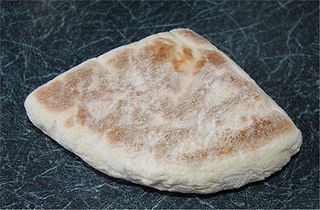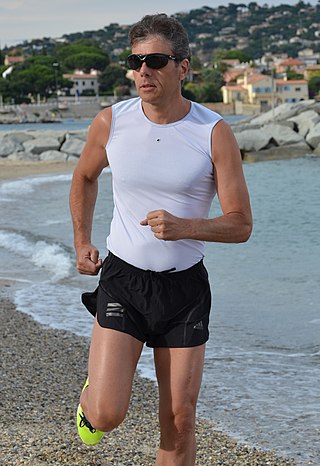
Ticino, sometimes Tessin, officially the Republic and Canton of Ticino or less formally the Canton of Ticino, is one of the 26 cantons forming the Swiss Confederation. It is composed of eight districts and its capital city is Bellinzona. It is also traditionally divided into the Sopraceneri and the Sottoceneri, respectively north and south of Monte Ceneri. Red and blue are the colours of its flag.

A baguette is a long, thin type of bread of French origin that is commonly made from basic lean dough. It is distinguishable by its length and crisp crust.

Dough is a thick, malleable, sometimes elastic paste made from grains or from leguminous or chestnut crops. Dough is typically made by mixing flour with a small amount of water or other liquid and sometimes includes yeast or other leavening agents, as well as ingredients such as fats or flavorings.

Soda bread is a variety of quick bread traditionally made in a variety of cuisines in which sodium bicarbonate is used as a leavening agent instead of the traditional yeast. The ingredients of traditional soda bread are flour, baking soda, salt, and buttermilk. The buttermilk in the dough contains lactic acid, which reacts with the baking soda to form tiny bubbles of carbon dioxide. Other ingredients can be added, such as butter, egg, raisins, or nuts. An advantage of quick breads is their ability to be prepared quickly and reliably, without requiring the time-consuming skilled labor and temperature control needed for traditional yeast breads.

Challah is a special bread of Ashkenazi Jewish origin, usually braided and typically eaten on ceremonial occasions such as Shabbat and major Jewish holidays. Ritually acceptable challah is made of dough from which a small portion has been set aside as an offering. Challah may also refer to the dough offering. The word is biblical in origin, though originally referred only to the dough offering. Similar braided breads such as kalach and vánočka are found across Central and Eastern Europe.

A bread making machine or breadmaker is a home appliance for baking bread. It consists of a bread pan, at the bottom of which are one or more built-in paddles, mounted in the center of a small special-purpose oven. The machine is usually controlled by a built-in computer using settings input via a control panel. Most bread machines have different cycles for different kinds of dough—including white bread, whole grain, European-style, and dough-only. Many also have a timer to allow the bread machine to function without operator input, and some high-end models allow the user to program a custom cycle.
The Ticinese dialect is the set of dialects, belonging to the Alpine and Western branch of the Lombard language, spoken in the northern part of the Canton of Ticino (Sopraceneri); the dialects of the region can generally vary from valley to valley, often even between single localities, while retaining the mutual intelligibility that is typical of the Lombard linguistic continuum.

The Università della Svizzera italiana, sometimes referred to as the University of Lugano in English-speaking contexts, is a public Swiss university established in 1995, with campuses in Lugano, Mendrisio and Bellinzona. USI is the only university in Switzerland where the official language is Italian, but many of its programs are in English.

In cooking, proofing is a step in the preparation of yeast bread and other baked goods in which the dough is allowed to rest and rise a final time before baking. During this rest period, yeast ferments the dough and produces gases, thereby leavening the dough.

Someo is a village and former municipality in the district of Vallemaggia in the canton of Ticino, Switzerland.

Kūčiukai also called Christmas cakes - is a traditional Lithuanian dish served on Kūčios, the traditional Christmas Eve dinner in Lithuania. They are small, slightly sweet pastries made from leavened dough and poppy seeds. There are variations in sweetness, it is usually eaten dry but can be served soaked in poppy milk or with cranberry kissel. Initially they were made as small loaves of bread served for the spirits - vėlės.

Basler Brot, in Basel also Basler Laibli, is a bread traditionally made in the Swiss cantons of Basel-Stadt and Basel-Landschaft, but now popular in all of Switzerland. It is distinguished from other Swiss breads by a very soft, porous dough and a mealy, crunchy crust.
Burebrot, Bauernbrot, Pain paysan or Pane del nonno is a bread made in Switzerland. Unlike most other breads, which are mainly composed of flour, yeast and water, the Burebrot also contains milk.
Zürcher Murren, also called pain bernois, Bernerweggen, Spitzweggen, geschnittene Weggli or Zackenweggen are a type of bread roll traditionally made in the German-speaking part of Switzerland and, more rarely, in the Romandy.

Italian irredentism in Switzerland was a political movement that promoted the unification to Italy of the Italian-speaking areas of Switzerland during the Risorgimento.

Nicola Pfund is a Swiss Italian writer, blogger and journalist.

Costante Tencalla was a Swiss-Italian architect and sculptor.
Piero Bianconi was a Swiss-Italian writer and academic.
Giovanni Bianconi was a Swiss-Italian poet, artist and ethnographer.

















